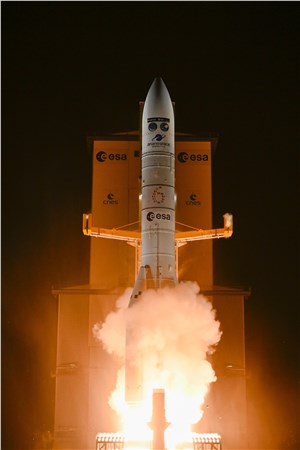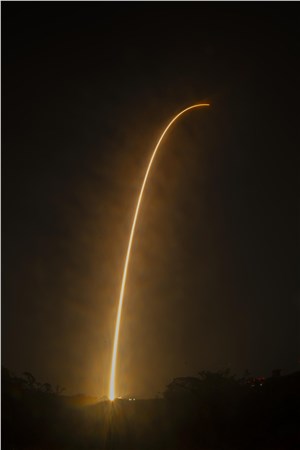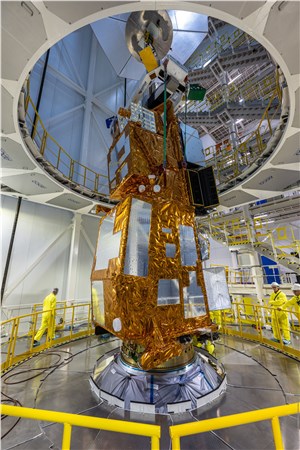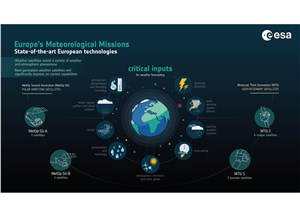




Ushering in a new era of weather and climate monitoring from polar orbit, the first in a new series of satellites, MetOp Second Generation, has been lofted into orbit aboard an Ariane 6 rocket from the European spaceport in Kourou, French Guiana. As part of this new satellite’s sophisticated instrument package is the new Copernicus Sentinel-5 instrument, which is designed to deliver critical data on air pollutants, ozone and climate-related gases.
Lifting off on 13 August at 02:37 CEST (12 August 21:37 local time), the Ariane 6 rocket carried the four-tonne satellite into orbit around Earth. Confirmation that MetOp-SG-A1 was alive and well came at 04:47 CEST, after its solar array had been deployed, ensuring that the satellite could generate power.
Building on the legacy of the first-generation MetOp satellites, the MetOp Second Generation (MetOp-SG) mission ensures the continued delivery of essential data for global weather forecasting and climate analysis – with significantly enhanced capabilities.

Market forecasts by Region, System Elements, Spectral range, and End-User. Market Overview, Key Technologies and Developments , Market Dynamics, Impact Analysis, and Leading Companies
Download free sample pages More information
MetOp-SG-A solar panel deployment
The all-new MetOp-SG mission comprises three successive pairs of satellites. Each MetOp-SG pair is made up of an A-type and a B-type satellite that carry a different, but complementary, suite of remarkable instruments to capture a wide range of observations.
This mission is the result of long-standing collaboration between ESA and Eumetsat. ESA is responsible for the design and development of the satellites, while Eumetsat manages the launch services, ground segment development, satellite operations and distribution of data to the meteorological community.
This first satellite is an A-type, MetOp-SG-A1, which includes the Sentinel-5 spectrometer for Copernicus – the Earth observation component of the European Union’s space programme.
ESA’s Director of Earth Observation Programmes, Simonetta Cheli, said, “Today’s launch highlights the value of strong partnerships between ESA, Eumetsat, the EC, Arianespace and Europe’s space industry. We thank all who has been involved.
“With increasingly erratic weather patterns, timely and precise forecasting has never been more crucial, and the MetOp-SG mission is now set to play a critical role in improving weather forecasts and climate monitoring. Sentinel-5 too will bring timely data for air pollution monitoring and more.”
Director General at Eumetsat, Phil Evans, added, “Extreme weather has cost Europe hundreds of billions of euros and tens of thousands of lives over the past 40 years – storms like Boris, Daniel and Hans, record heatwaves and fierce wildfires are just the latest reminders.
“The launch of Metop-SG-A1 is a major step forward in giving national weather services in our member states sharper tools to save lives, protect property, and build resilience against the climate crisis.
“These positive impacts will be felt even beyond that and over the Atlantic, as MetOp-SG-A1 is Europe’s first contribution to the Joint Polar System with NOAA. This milestone reflects years of teamwork across Eumetsat, ESA, the EU, CNES, DLR, Airbus, and many others. This is the beginning of an exciting new chapter as we work to ensure the satellite settles into orbit and starts delivering the vital data it was built to provide.”
Christoph Kautz, Director for Space Policy, Satellite Navigation and Earth Observation at the European Commission Directorate General for Defence Industry and Space, also congratulated the teams involved in the launch of Copernicus Sentinel-5A.
He said, “Orbiting Earth every 100 minutes, this new instrument will provide daily global data on air pollutants and atmospheric trace gases. The data will be supplied to the Copernicus Atmosphere Monitoring Service and Climate Change Service, which in turn will help authorities monitor pollution, track climate change, and inform decision-making.”
Powerful sensors for weather, climate and air quality
The MetOp-SG mission is made up of six satellites that will operate in successive pairs over the next 20 years, at least. Each of the three pairs consists of an A-type and B-type satellite, which carry complementary state-of-the-art instruments to provide high-resolution measurements of temperature, precipitation, clouds and winds for weather forecasting and climate analysis.
Marc Loiselet, ESA’s Project Manager for the MetOp-SG mission, said, “It’s wonderful to know that the first in the series is now safely in orbit and we will be monitoring it very closely as part of the in-orbit verification phase. Both types of satellite are extremely complex, so, I too, would like to thank everyone who has been self in the development and its road to orbit.
Although our focus has been very much on getting MetOp-SG-A1 ready for liftoff over the last months, we also have its partner satellite, MetOp-SG-B1 on the horizon, which is set to launch next year to complete the first pair.”
MetOp-SG A1 carries six instruments: a next-generation infrared atmospheric sounder, a microwave sounder, a multispectral imaging radiometer, a novel multiviewing, multichannel, multipolarisation imager, a radio occultation sounder (which is also embarked on the MetOp-SG-B satellites), and the Copernicus Sentinel-5 spectrometer.
The type-B satellites will carry five instruments: a scatterometer, the other radio occultation sounder, a novel microwave imager, a novel ice-cloud imager, and an Argos-4 data collection system.
They are the first ESA-developed satellites to carry a system for active disposal at their mission’s end. Each MetOp-SG satellite is fitted with an extra thruster, enabling it to self-destruct in Earth’s atmosphere when the mission is complete.
About Copernicus Sentinel-5
Copernicus Sentinel-5 instrument
Didier Martin, ESA’s Sentinel-5 Project Manager, noted, “It was incredible to see the Ariane 6 launch, taking MetOp-SG-A1 with the Sentinel-5A spectrometer to the skies. So many have worked hard to develop this sophisticated instrument.
“We are excited to see how it will perform in space, delivering data on atmospheric trace gases such as ozone, nitrogen dioxide, sulphur dioxide, formaldehyde, glyoxal, carbon monoxide and methane, as well as aerosols and UV radiation. These components not only affect the air we breathe, but also our climate.”
Copernicus Sentinel-5 is the result of close cooperation between ESA, the European Commission and Eumetsat. It was developed under the responsibility of ESA, by a consortium led by Airbus Defence and Space in Ottobrunn, Germany.
Complementary views
The MetOp-SG satellites circle Earth from pole to pole as the planet rotates beneath them, covering the globe approximately every 24 hours. In addition, their relatively low orbital altitude enables them to capture highly detailed measurements of various atmospheric conditions.
This capability is complemented by Europe’s other main weather mission, the Meteosat series, which operates in geostationary orbit. Positioned around 36 000 km above the equator, these satellites remain fixed relative to Earth’s rotation. This fixed, high-altitude geostationary orbit allows a large portion of Earth’s surface to remain in constant view to monitor fast-evolving weather systems. The second Meteosat Third Generation satellite, MTG-S1 – which also carries the Copernicus Sentinel-4 instrument – was launched in July.
With their different perspectives on Earth, having both types of weather mission in orbit maximises the effectiveness of data delivery for weather forecasting, prediction models and climate analysis.
About Ariane 6
Ariane 6 is Europe’s heavy launcher and a key element of ESA’s efforts to ensure autonomous access to space for Europe’s citizens. Its modular and versatile design allows it to launch all missions from low-Earth orbit into deep space. Standing over 60 metres tall, Ariane 6 can weigh almost 900 tonnes when launched with a full payload.
Ariane 6 has three stages: two or four boosters, and a main and upper stage. For this launch, the rocket was in its two-booster configuration.
The main stage and the solid rocket boosters are responsible for the first phase of flight. The stage is powered by the Vulcain 2.1 engine (fuelled by liquid oxygen and hydrogen), with the main thrust at liftoff provided by the P120C boosters.
The upper stage is powered by the reignitable Vinci engine fuelled by cryogenic liquid oxygen and hydrogen. The upper stage will fire two times to reach the required orbit for this mission.
After separation of the payload, Ariane 6 had a final burn planned to deorbit the upper stage and reduce space debris.